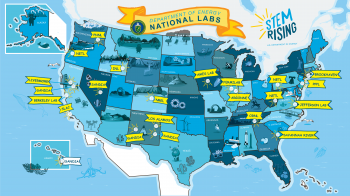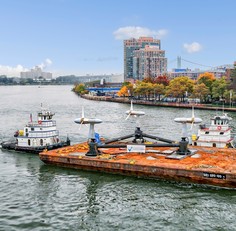 What’s Inside: This edition of the Water Wire shares recent announcements, upcoming events, newly released products and publications, STEM and Black History Month spotlights, a featured project from the 2019-2020 Accomplishments Report, and other hot topics.
Sign up for our brand new Hydropower and Marine Energy listservs to dive deeper into our technologies, activities, and successes!
Reach out to us at WaterPowerTechnologiesOffice@ee.doe.gov with any inquiries or suggestions.
Estimated read time: 7 minutes and 20 seconds.
Announcements
DOE Announces $100 Million for Transformative Clean Energy Solutions
On February 11, the Department of Energy (DOE) announced up to $100 million in funding for transformative clean energy technology research and development via its Advanced Research Projects Agency-Energy’s OPEN 2021 funding opportunity. This funding will help identify cutting-edge, disruptive clean energy technologies to address the climate crisis. The technical categories of interest include multiple areas relevant to marine energy and ocean research, such as power generation from hydrokinetics and non-automotive ground/sea transportation. Concept papers are due April 6.
Upcoming Webinars & Events
WPTO Semiannual Stakeholder Webinar Features New Acting Head of EERE
Join us on March 1, from 3:30–5:00 p.m. ET, for our semiannual stakeholder webinar, where we’ll discuss some of the most pressing changes affecting water power R&D in 2021. The webinar will feature program managers and technical leads from across WPTO who will provide an update on the administration transition, highlight recent announcements and publications, share project updates, and discuss upcoming priorities.
The event will also feature Kelly Speakes-Backman, Acting Assistant Secretary for Energy Efficiency & Renewable Energy (EERE) and Alejandro Moreno, Acting Deputy Assistant Secretary for Renewable Power and WPTO Director.
This webinar is one of WPTO’s many efforts to improve transparency and engagement with stakeholders in the hydropower and marine energy industries. Register for the webinar and email questions ahead of time for WPTO staff, Alejandro, and/or Kelly.
CEATI International’s 12th Annual Hydropower Conference
On March 2-4, join thousands of industry peers at CEATI International’s 12th Annual Hydropower Conference, which will focus on the risk and uncertainty that hydropower owners and operators currently face. Oak Ridge National Laboratory’s (ORNL) Brenda Pracheil will be presenting on hydropower flexibility and environmental tradeoffs, and Argonne National Laboratory’s Jim Miller and ORNL’s Pradeep Ramuhalli will give a joint overview of the Hydropower Fleet Intelligence project and present recent research results. If you’re planning to attend, check out the conference agenda to learn more about the national lab speakers and don’t forget to check out WPTO’s virtual booth while you’re there!
8th Annual World Ocean Summit
On March 1-5, join more than 5,000 participants and 150 speakers at the 8th Annual World Ocean Summit, where staff from the Economist will present findings from their new report, Accelerating Energy Innovation for the Blue Economy, created in partnership with Pacific Northwest National Laboratory. Organized by The Economist, the 2021 events aims to deliver action-oriented insights into creating a sustainable ocean economy. Register for the virtual event.
Discussion on the Future of the Marine Energy Collegiate Competition
Part of WPTO’s ongoing STEM Dialogue Workshop Series, NREL and the Hydropower Foundation will host a workshop about the DOE Marine Energy Collegiate Competition (MECC), which challenges students to advance the burgeoning marine energy industry. During the event, NREL and WPTO staff will review the structure and requirements of the first two MECCs and gather feedback that can be used for future competitions. Members of the marine energy community are invited to join the discussion on March 9, from 5:00-7:00 p.m. ET. Register for this event.
Products & Publications
NREL Releases Marine Energy Resource Summary Report
The National Renewable Energy Laboratory (NREL) recently published a report titled Marine Energy in the United States: An Overview of Opportunities, which summarizes the best available data on U.S. marine energy resources at the state and regional scales. The results within the report are primarily based on DOE-funded marine energy resource assessments in technology areas such as wave, tidal currents, ocean currents, ocean thermal gradients, and river currents published between 2011 and 2013.
 Technical power potential of U.S. marine energy resources (in TWh/yr) for the United States, U.S. territories, and freely associated states.
Using Additive Manufacturing to Produce Advanced Hybrid Composite Structures for Marine Energy Systems
While marine energy developers are beginning to implement composite materials into the load-bearing structures of their devices, traditional mold-making costs for composite prototyping are disproportionately high and lead times can be long. New WPTO-funded research from NREL explores the possibilities of additively manufactured internal composite molds and how they can be used to reduce costs and lead times through novel design features and processes for marine energy composite structures. View the full text to learn more about NREL’s successfully manufactured reduced-scale composite tidal turbine blade, as well as key areas they identified for continued research for future marine energy systems.
Sandia Researchers Dive into Wave Energy Trends and Tools
Earlier this year, researchers at Sandia National Laboratories (Sandia) published a variety of publications that assess the research needs and findings surrounding wave energy. Read up on exciting topics such as historical trends in wave energy climate for coastal waters, co-design for wave energy converter (WEC) optimization, a novel approach for delineating dominant resolved wave energy systems, and the need for numerical tools to support the design of WECs. Visit Sandia’s website to learn more about their water power research portfolio.
New Data and Features on the SLOPE Platform Supports Hydropower Planning
The State and Local Planning for Energy (SLOPE) Platform now has exciting new datasets to help state and local energy planners make data-driven decisions. SLOPE informs cost-effective energy planning at a high level, conveying jurisdiction-specific data on energy efficiency, renewable energy, and (coming in 2021) sustainable transportation opportunities through visualizations, maps, and charts. With 18 new datasets now incorporated in SLOPE, users can gain even more detailed insight into localized energy generation potential, including hydropower.
Energy planners looking to explore the potential of hydropower can use SLOPE to answer questions such as:
-
Are there non-powered dams in my community that could provide a new renewable energy resource?
-
How much electricity generation could my jurisdiction generate from new, small hydropower development?
Visit SLOPE to better understand your jurisdiction’s energy opportunities and potential and make more data-driven energy decisions.
STEM & Black History Month Spotlight
DOE Honors Black History Month
During Black History Month, we recognize DOE’s continued commitment to diversity, equity, and inclusion. The Department honored Black Americans’ contributions to DOE and the National Labs and celebrates a growing, diverse team of political appointees at DOE, a reflection of the Biden Administration’s commitment to diversity.
DOE also celebrates the many Black scientists, physicists, engineers, and technicians who contributed to the Manhattan Project, one of the most significant scientific achievements in the last 100 years. The Office of Legacy Management highlighted three of the extraordinary scientists who made a difference through scientific innovation.

DOE believes diversity and inclusion in the STEM workforce produces better results and is a mission imperative. America’s STEM needs are enormous, and we need an “all-hands-on-deck” approach to fill them. DOE’s STEM Rising initiative aims to ensure a diverse and inclusive energy workforce of today and tomorrow. Learn more about the programs DOE offers to support this vision. For information specific to water power STEM, check out the Hydropower and Marine Energy STEM Portals.
|
Delivering on STEM & Workforce Development for the Future of the Planet
President Biden said in his Inauguration last month, “A cry for survival comes from the planet itself, a cry that can’t be any more desperate or any more clear,” centering the climate crisis as a top priority in this administration. This work requires innovators who are ready to drive change, implementing the top technologies our country has to offer, and continuing to spur on advanced research and scientific discovery. For more than 60 years, DOE has run programs coast to coast to reach students from all 50 states, Puerto Rico, and the District of Columbia to inspire and train them to explore a STEM future. At STEM Rising, you can find information about all of the agency’s programs, digital resources, events and news regarding building the future STEM workforce through education, outreach and workforce development activities. To learn more, check out STEM Rising Director AnneMarie Horowitz’s blog post and visit the STEM Rising website.
2019–2020 Accomplishments Report: Project Spotlight
Verdant Power’s Tidal Testing Underway in New York’s East River

Founded in 2000, Verdant Power's mission is to “help build sustainable communities through a holistic approach focused on clean energy generation as well as advancing partnerships and hybrid platforms to make significant impacts at the energy-water nexus.” Through its Roosevelt Island Tidal Energy Project in the East River of New York City, Verdant has developed expert capabilities in the areas of marine energy systems design and operations; water resource assessment and site feasibility analysis; and environmental monitoring and project licensing.
Since deploying in the East River, Verdant has reported the project set a record for U.S. marine energy generation by demonstrating 100 percent availability, while generating 100 megawatt-hours (MWh) in only 85 days of continuous operation. This is far sooner than projected, which means that it is on track to generate more than 430 MWh per year into the local grid. Dive into WPTO’s 2019-2020 Accomplishments Report to learn more about WPTO’s partnership with Verdant Power, and tune into a conversation with Verdant Power’s Chief Technology Officer Dean Corren on Con Edison New York’s Current Thought podcast.
|
In Case You Missed It
WPTO Announces Waves to Water Prize ADAPT Stage Finalists
On February 9, WPTO announced 10 finalists for the Waves to Water Prize ADAPT Stage. This third stage challenged competitors to design flexible systems to meet site conditions at Jennette’s Pier in the Outer Banks of North Carolina. Offering $3.3 million in prizes, Waves to Water is focused on advancing transformational technology to meet the global need for secure and affordable water. With the conclusion of the ADAPT Stage, competitors will now transition to the CREATE Stage and focus on building a functional prototype of proof-of-concept of their system and develop a plan to build and deliver their technology for the final DRINK Stage. Learn more about the Waves to Water Prize and the winning competitors.
Upstream Tech Announces a Partnership for Forecasting Technology with ENGIE in 2021
Upstream Tech—part of Natel Energy and an environmental technology company currently funded by a DOE Phase I Small Business Innovation Research grant—recently announced its partnership with ENGIE, a multinational electric utility company, to provide inflow forecasting for the company's newly acquired hydroelectric portfolio in Portugal. Upstream Tech's HydroForecast™ is an end-to-end modeling and decision support service that combines physical theory with artificial intelligence and satellite imagery to provide accurate and reliable hydrological forecasts. These forecasts contain the future expected conditions of surface water flows, such as how much water will flow into a lake over the next 10 days, enabling hydropower asset owners to effectively plan operations. Read the full press release and Upstream’s academic research and publications to learn more.
|